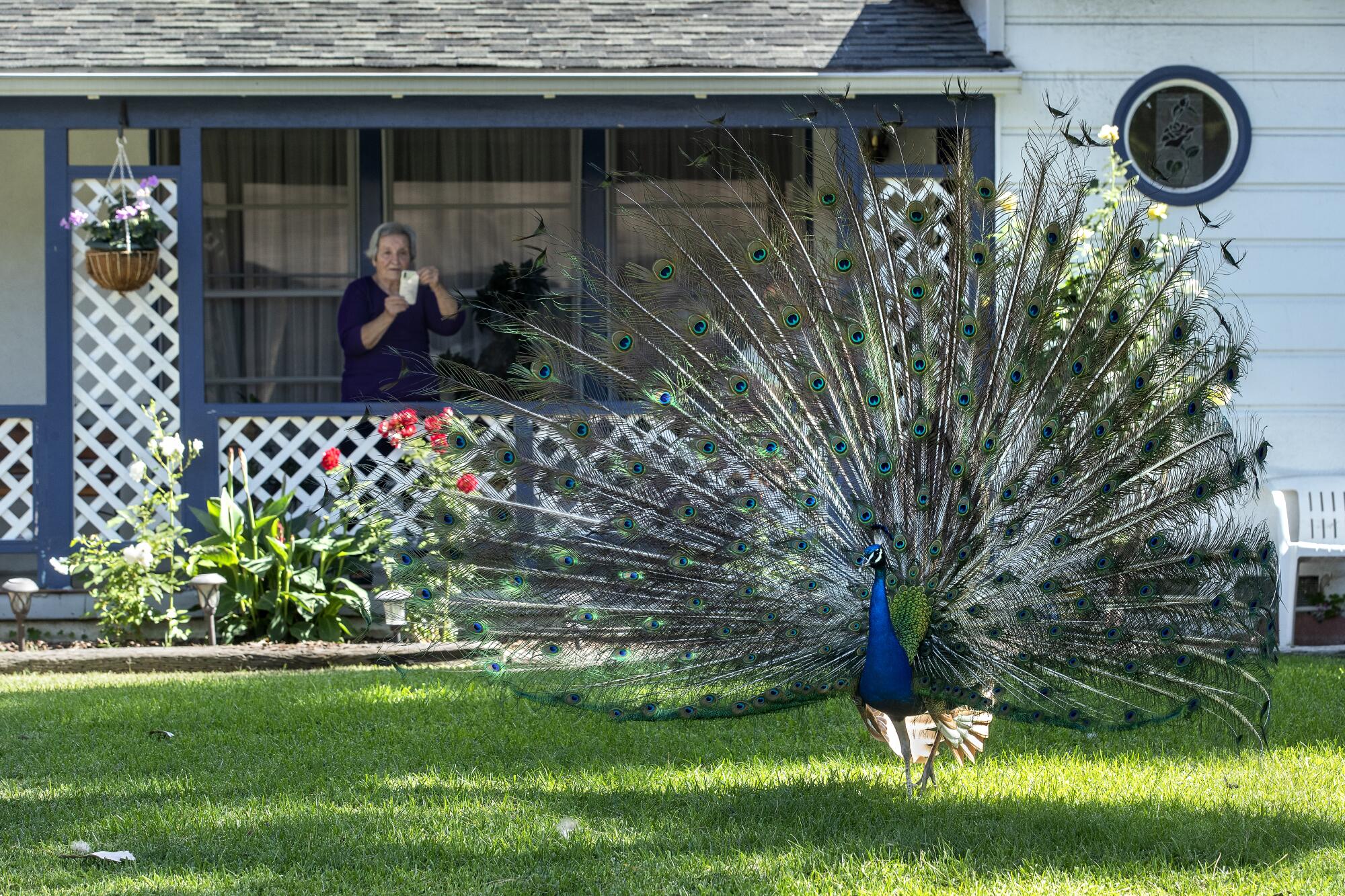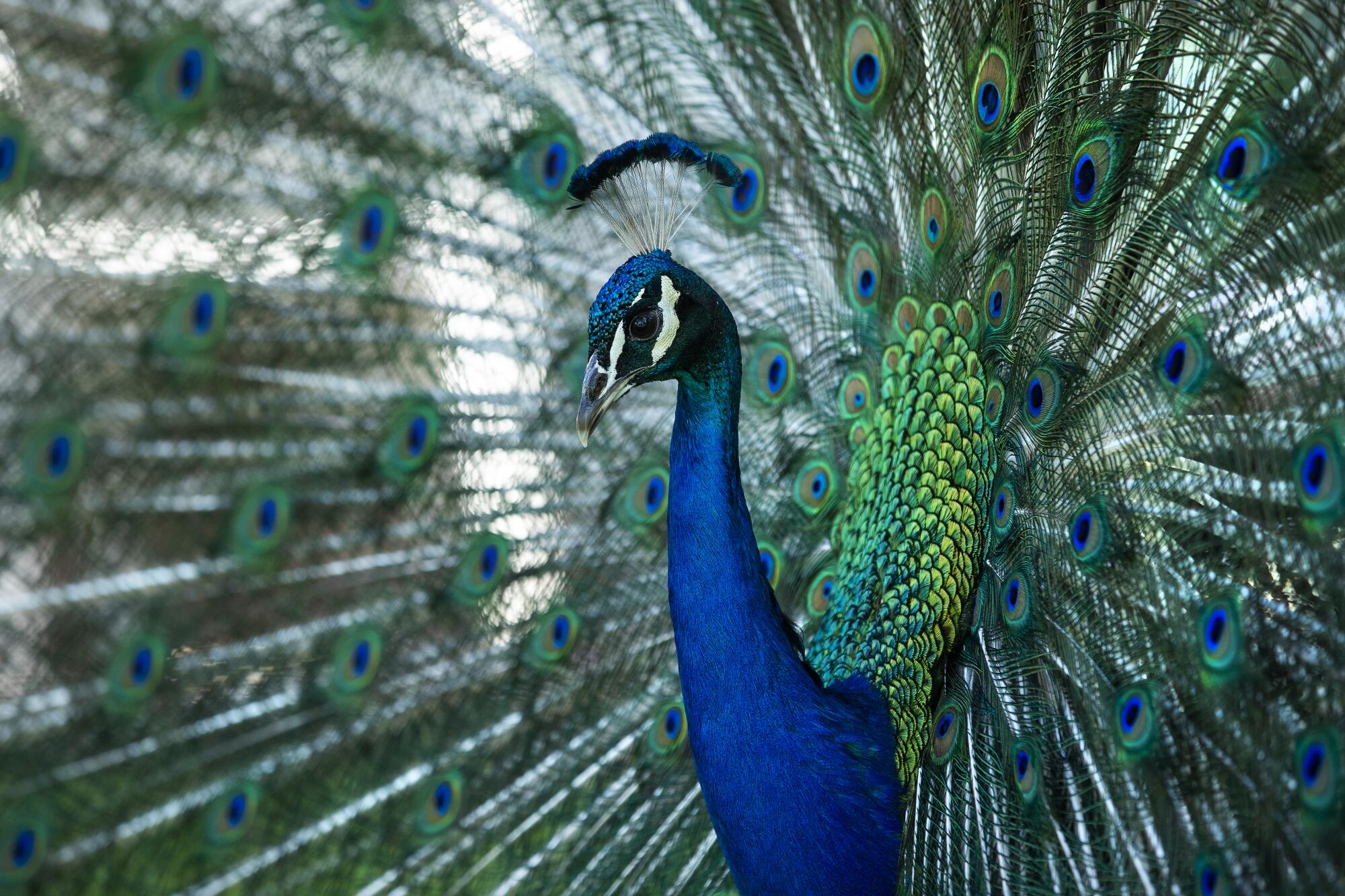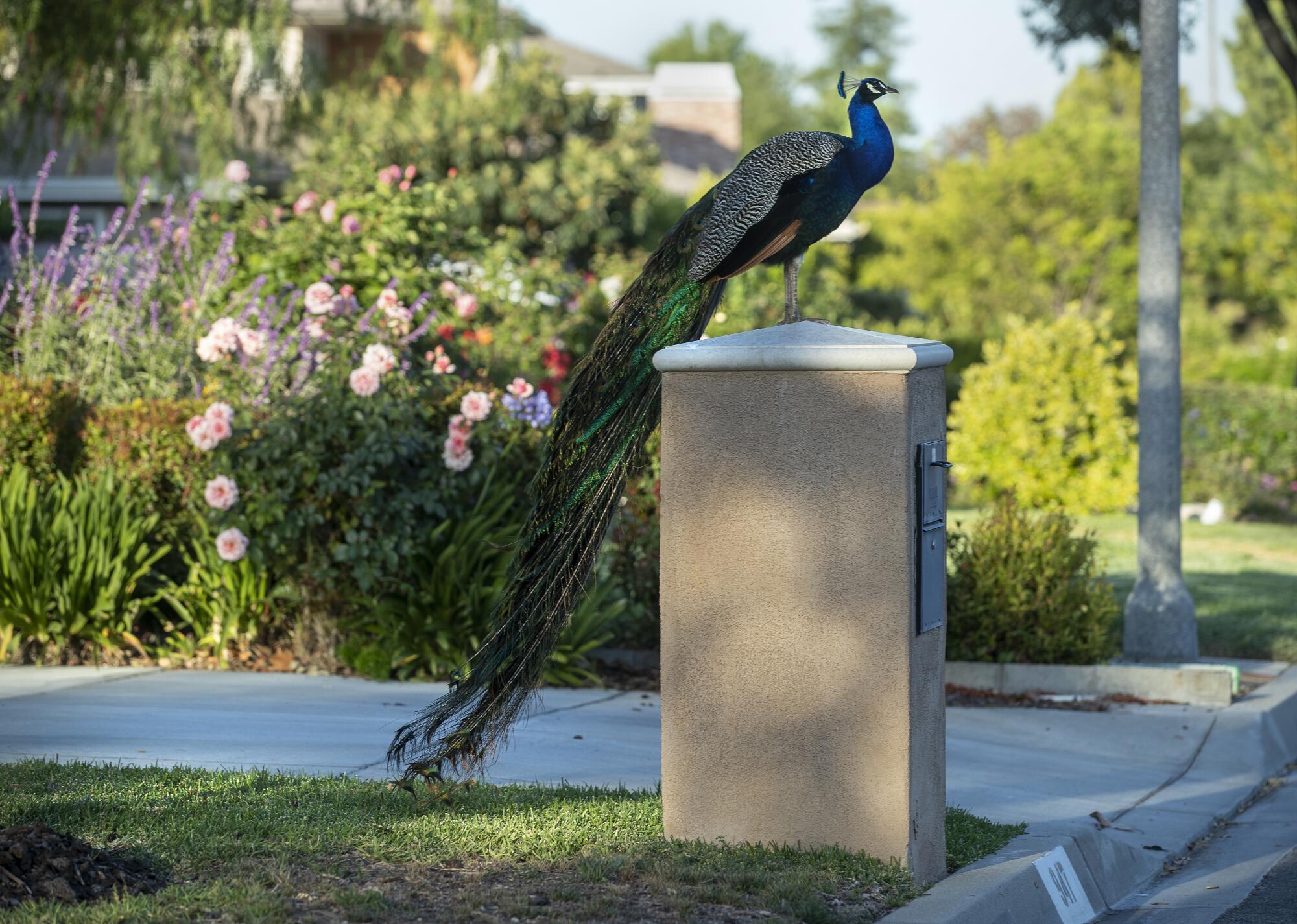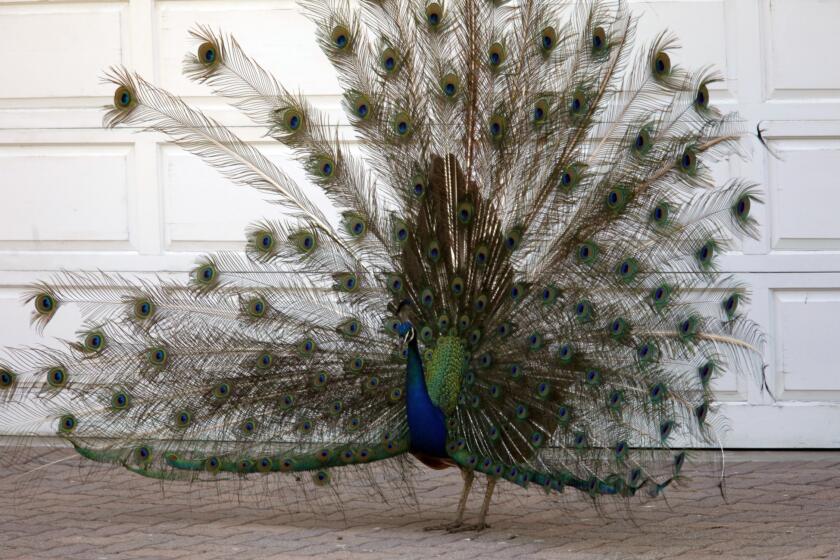
It’s a fowl topic that has pitted neighbor versus neighbor over some brilliantly plumed invaders: peacocks.
For lovers of the birds, the peacocks are a cultural treasure worthy of being fed and tended and allowed to run free and unfurl their tail feathers across streets and lawns of homes in the western San Gabriel Valley.
For the anti-peacock contingent, they are a menace that blocks traffic, destroys gardens, screeches incessantly and poops on roofs and cars. There are peacock fans who welcome the birds onto their yards to drink from bowls of water, and peacock haters who erect fences, install nets to keep them out and even try to poison them or run them over. In East Pasadena, one resident even tried to hire a trapper to capture and relocate peafowl from the neighborhood.
“I can’t believe it.... It seems like you either love them or you hate them,” said Mike Maxcy, a retired zookeeper who contracts with city and county governments to relocate peacocks whose feathery displays adorn and agitate a swath of the valley from Altadena to Arcadia. “I’ve been doing this as a side job for over 20 years, and I’ve never seen such a polarizing topic or discussion as the peafowl.”
At the heart of the debate is whether people should be allowed to feed the feral peafowl, which can become aggressive when they become dependent on humans who scatter bread crumbs, dog food and bird food in their yards and driveways for the large birds.

The issue has become so contentious that the Los Angeles County Board of Supervisors recently voted to draft an ordinance that will prohibit residents from feeding the animals.
Supervisor Kathryn Barger, whose San Marino neighborhood is home to peacocks, led the initiative to prohibit feeding. She said that the cities of Pasadena and Arcadia already prohibit feeding peafowl in their municipal codes, and that it’s time for the county to follow suit. While it’s unknown exactly how many peafowl live in L.A. County, county officials say that there are easily hundreds, and that over the last two years, the population has exploded.
“They actually do just fine without us feeding them,” Barger said. Feeding them “is creating a larger population that is breeding, and it is impacting the communities.”
To stop a virus, California has euthanized more than 1.2 million birds. Is it reckless or necessary?
Each morning, once the kids were off to school, Kerri Hand would slip out to her backyard, sit in a lawn chair and hang out with her feathered family.
To understand the full peafowl problem in L.A. County, one must first learn some terms.
A male bird is called a peacock. A female is a peahen. Their tiny chirping young are called peachicks. A group is, appropriately, called an ostentation, but sometimes also dubbed a muster or a pride.

The birds are not native to L.A. County, or Southern California.
Rather, in the late 1800s, a California businessman named Elias J. “Lucky” Baldwin was building his own personal Eden in the San Gabriel Valley, planting fruit trees and raising livestock on his massive Rancho Santa Anita acreage. At some point, Baldwin added peafowl to his collection.
No one knows when or how Baldwin imported the blue peacocks from India, but some early reports claimed he got them on a trip to the country in the late 1800s.
“A lot of people came and took peacocks back with them because it was very easy thing to do,” said Bikram Grewal, a respected conservationist in Delhi who has written several books about birds in India. “You could buy them from the dealers. … The blue ones were a dime a dozen.”
Florida has its Burmese pythons, Louisiana has its beaver-like nutria, and Rancho Palos Verdes has its peacocks.
Still, there’s no record of Baldwin’s peafowl purchase.


Historian Sandy Snider, who worked at the Los Angeles County Arboretum and Botanic Garden in Arcadia for 35 years, said that in researching the origins of Baldwin’s peafowl, she found a few California newspapers advertising peafowl for sale in the late 1800s in Marysville and other towns.
“In the absence of written documentation, best guess from this historian is that Lucky didn’t look as far as India for his peafowl purchase,” Snider said.
Regardless, when the state and county jointly purchased 111 acres from Rancho Santa Anita Inc. to create the arboretum, they inherited the peafowl — and the drama they bring.
For decades, the arboretum staff have fielded calls from angry residents demanding they come pick up the peacocks from their yards.
“I will have messages on my machine saying, ‘Oh, could you guys please get this peacock? It’s on Huntington Drive and Colorado,’” said Robin Sease, the arboretum’s director of visitor experience. “Unfortunately, we do not do that. They’re wild animals.”
Local officials and residents have taken a number of approaches over the years to get peafowl prides under control. Residents have drafted petitions — both for and against the peacocks. At least twice, the county has auctioned off the birds, including in 1960 when the arboretum sold about 150 peafowl.

One of the purchasers was a 6-year-old boy named Paul Valenzuela, who wrote a letter to the arboretum’s director asking whether he could pay $1 for a “mama and a daddy,” after reading about the auction in a newspaper. (The arboretum director chipped in an additional $3, as the purchase price for a pair was $4.)
Valenzuela, now 68, said the birds happily existed, and reproduced, in a large aviary his father built on their land in Sylmar until a massive rainstorm swept through town. As water flooded into their birds’ cage, his father told Valenzuela and his brother to release the 50 peafowl still alive.
The family’s birds relocated to the Olive View Sanatorium, where Valenzuela visited them until the family moved elsewhere.
“I bet there’s still peacocks around the hospital,” Valenzuela said. “Those beautiful birds were never designed to live in an urban environment because they are so intrusive, and they are hunters and tend to claw. But they are beautiful.”
Because of the arboretum, the epicenter of peacock enthusiasm, and ire, has long been Arcadia.
The fowl are held in such high esteem that they became the inspiration for the new mascot for the Downtown Arcadia Improvement Assn. The mascot’s name: Perdy Peacock.
Perdy dances in TikTok videos and will be the main attraction at the city’s July 3 parade, said Donna Choi, executive director of the improvement association. She said Perdy has become so popular that she’s thinking of giving him a security detail.

Peacocks are part of the city’s culture, Choi said. Ever since Baldwin brought the peafowl over, “they have been a source of pride for us.”
Because of the COVID-19 pandemic, there are fewer cars and people on the streets. More peacocks have started venturing into downtown, she said.
“I think that the peacocks have their home, and we should coexist,” Choi said. “I think it’s a great opportunity for all of us to learn how to live with each other.… I mean, how many communities can say they have peacocks running around?”
Though peafowl aren’t native, they’ve become naturalized to Southern California‘s climate and are protected by law since being introduced to the San Gabriel Valley in the late 1800s and later the Palos Verdes Peninsula.
When asked recently about peacocks, Pasadena resident Kenneth McPheeters, 66, shook his head and muttered, “Out of control.”
He wishes the peacocks would be contained and supports the proposed ordinance to bar feeding them.
“They’re a nuisance,” he said. “I’m a yard man, I love a beautiful yard, and they eat up my flowers.”

Another Pasadena resident, 53-year-old Michelle Pantoja-Hooley is a peacock fan.
“I’ve fed them,” she said with a sheepish chuckle. “And my neighbors shame me.”
A few years ago, she noticed a peacock — she named him George — that was hobbling, abandoned by other peafowl. She and her husband spent three months giving water and food to George. Other hungry peacocks soon appeared outside her house. One photo she took shows 10 of them congregating on her lawn. She thinks she sees George from time to time.
“Sometimes I think I see him because there’s one that hobbles,” she said.
Because of the Board of Supervisors proposal, Pantoja-Hooley is considering no longer feeding the birds. But she will still put out water.
“I know that they do peck cars. I saw them peck a Tesla,” Pantoja-Hooley said. “But I think they’re beautiful. They’re unusual. They give our little area ... that little something.”
More to Read
Start your day right
Sign up for Essential California for news, features and recommendations from the L.A. Times and beyond in your inbox six days a week.
You may occasionally receive promotional content from the Los Angeles Times.











